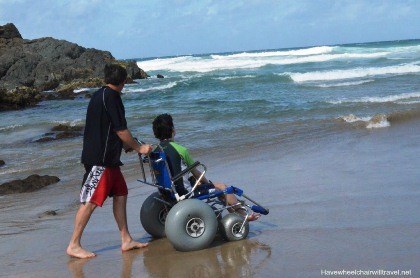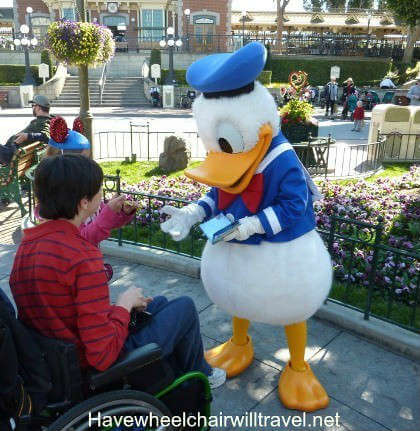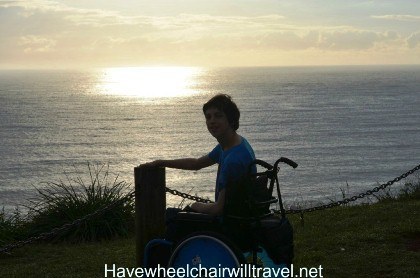Travelling with a wheelchair
This week we have a fantastic guest blog post from Julie Jones from Have Wheelchair Will Travel. Julie shares her knowledge about travelling with a family member who has a wheelchair or disability, as well as sharing a positive attitude you just want to breathe in and harness for yourself. You can find more information about travelling with a wheelchair on the website or follow them on Facebook for great tips and stories.

As a child Julie Jones was lucky enough to travel extensively. Julie still wants to travel and at the same time still wants to share the joy of travel with her children. Julie now shares her knowledge about travelling with a family member who has a wheelchair or disability through her website, Have Wheelchair Will Travel.
When I think of travel I think of spontaneity, adventure, letting go of work and home commitments and ultimately a sense of freedom! It conjures up scenes in movies of the open road, standing atop a mountain or huge smiles as people complete an adrenaline thrill and survive!
When our son was diagnosed with a disability a wheelchair became part of our ‘baggage’ and I wondered how we’d travel. There seemed so much to consider. Even when we went two hours up the coast, our car was weighed down and fully loaded.
Well, several trips later I can report that with meticulous planning (which means spontaneity went out the window!) we had the joy of adventure and freedom. The freedom seemed twice as sweet because we felt even more liberated managing to travel with a wheelchair and had a fantastic time.
Here are a few of my tips for booking a holiday with a wheelchair.
Everyone with a disability has different needs so these are just some general tips. Firstly, decide on a destination you feel comfortable with for your initial trip. Starting local gave us a good idea of what we found essential on a holiday. When we did take the plunge to travel further afield we were more confident choosing accommodation and certainly knew what questions to ask following some interesting experiences!
Considerations when booking flights and accommodation
When booking accommodation we usually book longer stays in one place as we find that we are slower travellers with a wheelchair. We also understand we can’t fit in the same amount of sightseeing into our travel day as we did as a couple. Accommodation that is centrally located means that it isn’t necessary to get in and out of the car for something as simple as going to dinner.
If the person with a disability needs their carer or companion to assist them in the bathroom check to see if the airline you are booking with has a disabled toilet on board (these are just larger in size).
Booking flights
When booking flights the airline will need to know the dimensions of your wheelchair (height, width and approximate weight) and will want to know if it is manual or electric. Have this information available to save time. Let the airline know if you prefer, or need your own wheelchair to the aircraft door.
The airlines have an upper body torso harness available to help passengers with a disability with poor torso control but these must be pre arranged through special handling at time of booking. These harnesses can only be used in specific seats on the aircraft.
Advise the airline of any dietary requirements and any special equipment you need to carry on board (e.g. we had medication that required an esky and dry ice).
Hotel bookings
If booking online or through a travel agent I suggest once the booking is made phone the hotel direct. Double check all the details and ensure the hotel understands your requirements. Accessible rooms vary greatly. We found that in the US there was very detailed information on hotel websites, often including plans of the room layout and room measurements.; That’s handy to get an idea of how tight it will be with a wheelchair.
Don’t assume hotel staff or management know what you need. Ask questions to make sure you know if the room is on the ground floor and if not whether there is a lift. Check if there is a roll in shower and if needed a shower chair or flip down seat.
Transportation
Car Hire – there are specialty companies for wheelchair modified hire cars and vans. If you are booking just a station wagon or people mover with one of the major rental companies though ensure that it is noted in your booking that it is being booked to accommodate a wheelchair. Rental companies generally book a particular car and add ‘or similar’. It needs to be made clear that you require a certain type of vehicle for a reason.
Ensure that the transfer bus, if there is one, to the car hire depot is also accessible.
Shuttle buses – We have found that not all shuttle buses are fully wheelchair accessible. In LA they could not accommodate our son’s wheelchair because it does not fold. Melbourne airport shuttle can. It is just a matter of checking.

Attractions
Once you have decided which sights and attractions you wish to visit do some research about accessibility. Somewhere like Disneyland has extensive information on accessibility on their website. Other smaller attractions may need an email or phone call to check. Often entrances for wheelchairs are located in different spots or they may have special seating available if you contact them in advance. It saves a lot of time and frustration going armed with some information.
Tickets
Many attractions offer a free ticket for a carer/attendant so check for this and make an email enquiry if it is not on a website. The Australian Companion Card needs to be produced in Australia. We found in the USA it was accepted as a form of proof of disability at most attractions.
Preparing your wheelchair
A general service on your wheelchair is a good idea ensuring no nuts or bolts are loose and that everything is in good working order. We also take a basic repair kit which we get from our wheelchair manufacturer.
If you are getting a new wheelchair, my best tip is to get as much storage built in as possible. A zippered pocket under the seat, behind the seat and net storage underneath all come in handy when you travel.
Travel insurance
Once you’ve got your holiday booked, apply for your travel insurance to ensure you are covered for the unexpected. You should consider the type and amount of insurance you require for your wheelchair as it is an expensive piece of equipment and the airlines usually say “all care, no responsibility”.
Declare any existing medical conditions and ask if you are unsure about a condition. Despite my experience as an ex travel consultant I was surprised to learn my son’s disability, Cerebral palsy, is a pre-existing condition. In my mind he is a healthy boy with a disability NOT an illness or condition. It didn’t cause any problems to cover him but I am using it as an example of how it’s better to check than find you are not covered if something does go wrong.
Consider an annual multi-trip policy if you are travelling more than once throughout the year. We did this for the first time last year and it saves time, money and filling out forms! For example, Cover-More’s annual multi trip policy will cover you when you travel anywhere further than 250kms from home.
Packing
All the same rules apply to anyone packing but for your comfort make sure you have the things you need to make your trip as pleasant as possible. Check with your airline as to how much luggage you can have as a person with a disability. Qantas, for example, allowed us our luggage plus two pieces of mobility equipment in our luggage allowance.
Pack all medication in your hand luggage and have a letter from your GP covering the medication you are travelling with.
Airport/Onboard
Arrive early at the airport. You will avoid the worst of the queues and you do need more time at every step of the way. This will ensure you are not rushed.
People with limited mobility and those using a wheelchair are first to board the plane and last off. We always have drinks with us (buy or refill a water bottle once you have cleared security) because it is quite a wait and it is hot before the air conditioning system truly gets going on takeoff.
Unless you are fortunate enough to travel at the front end of the plane, most of us find economy seats on long haul flights confining and uncomfortable after several hours. We find this especially so for our son who is disabled. If finances permit consider premium economy for the extra room. If not, take whatever you think will most help the person be comfortable.

Lastly, travel with a positive attitude! Things can go wrong with any travel booking but a positive attitude will go a long way to ensuring your experiences and interactions are enjoyable.
The views, opinions and positions expressed by the authors and those providing comments are theirs alone, and do not necessarily reflect those of Cover-More Insurance.
Planning a trip?
Discover Our COVID-19 Cover
To find out what our current* benefits do – and don’t – cover, please read:
Plus, for helpful destination-based COVID-19 information, don't forget to check the COVID-19 Travel Risk Tool before and during travel.
*The cover information contained on the above pages refers to Cover-More policies sold on or after 26 June 2023. For cover information on policies sold prior to this date, please read the relevant PDS.